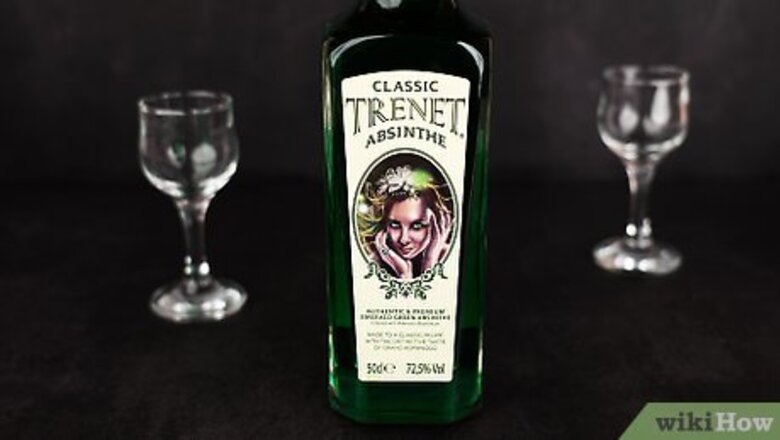
views
- You can drink absinthe neat or on the rocks, but the Classic French is a popular way to drink it.
- Absinthe is a great substitute if you want a fresh take on a Sazerac or whiskey sour.
Choosing Your Absinthe
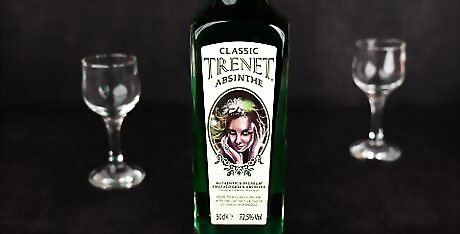
Select a quality bottle of absinthe. Absinthe is made using many different methods and ingredients. There are several standards that help one to determine if a particular brand of absinthe is authentic and of high quality. It is also possible to make absinthe, although this is dangerous and not recommended. Different brands of absinthe will contain anywhere from negligible amounts of thujone up to about 35 mg/kg thujone. See the Tips below for more about the role of thujone in absinthe. International standards require that alcoholic beverages that contain greater than 25 percent alcohol by volume contain no more than 10 mg/kg thujone, while bitter spirits may contain up to 35 mg/kg thujone. If an absinthe is labeled as a bitter, it will probably contain 10 to 35 mg/kg thujone. Thujone is illegal as a food additive in the United States, but authentic absinthe containing negligible amounts of thujone can be legally sold. Vintage bottles of pre-ban absinthe can be obtained, and it is reputed that some of the lesser quality versions contained inordinately high levels of thujone and harmful adulterants such as copper salts, aniline dye and antimony trichloride. These circumstances may have led to absinthe's poor reputation.
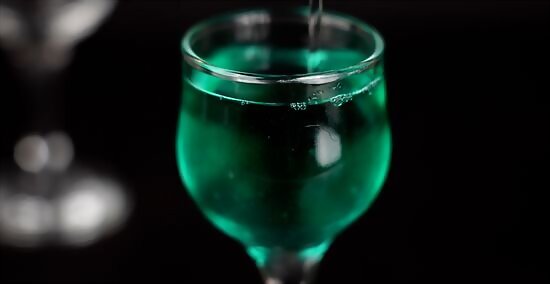
Be aware that quality absinthe should show the louche effect. It is desirable for absinthe to gradually demonstrate increasing turbidity (opaqueness) or turn partially translucent as ice water is gradually added to it. This is known as the louche effect. The louched color should demonstrate complexity as well as nuance, and the absinthe should not turn opaque rapidly. However, it must be noted that not all quality absinthe will turn opaque, as the louche effect is primarily produced by the herbs anise and fennel. Absinthe typically tastes like licorice due to the addition of such herbs. The louche effect is produced by the precipitation of the herbal essential oils.
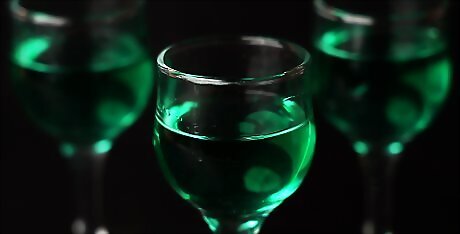
Select absinthe that is made from natural, whole herbal ingredients. The finest absinthe is made with whole, natural herbs and does not contain any artificial ingredients such as artificial colors and flavors. The herbs are merely ground up so that they can be efficiently used during the distillation and extraction processes. The pale-green color of typical high-quality absinthe is imparted by the chlorophyll that is extracted from whole, natural herbs. Absinthe that is bright green may be artificially colored. However, not all quality absinthe has a green color. Quality absinthe may also be clear, orange, or red, but the color should be imparted by natural herbal ingredients such as petite wormwood. Vintage absinthe may have an amber color, as the chlorophyll will have faded over time. If you're lucky enough to obtain a bottle of vintage absinthe, consider opening the bottle with a food scientist in order to ensure that the spirit is indeed safe to drink.
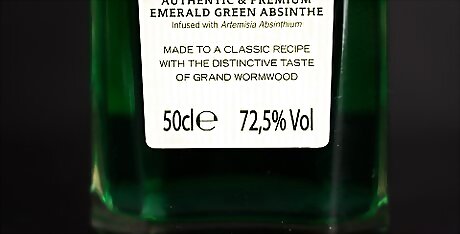
Select absinthe that has a high alcohol content. The best tasting absinthe falls into the range of 45-68 percent alcohol by volume. Absinthe has traditionally been about 136-proof. A very high alcohol content is not considered to be excessive because absinthe is traditionally diluted with water before drinking and it is meant to be sipped slowly over time, so as not to allow the effects of alcohol to overwhelm the subtle and pleasant effect of the herbs.
Classic French
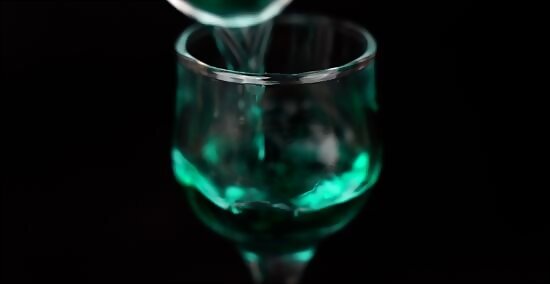
Pour about one ounce (30ml) of absinthe into a glass. There are various types of glasses that can be used, some of antique or historical design and others of more modern design. French absinthe glasses, such as reservoir pontarlier glasses, are quite suitable for the French absinthe ritual. Different styles of reservoir glasses are available, but every style will have a distinct or bulbous bottom area that indicates the amount of absinthe that is to be initially poured.
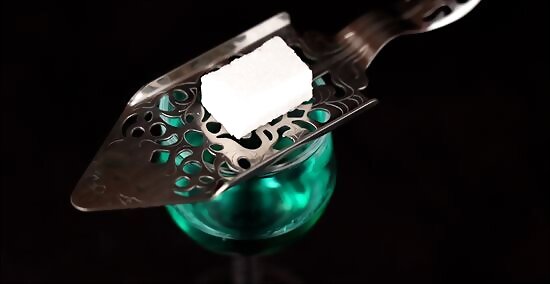
Lay a flat, perforated absinthe spoon across the rim of the glass, and place a single cube of sugar on the perforated area of the spoon. This is customary but is not necessary. The sugar is traditionally used to balance the bitter taste of the wormwood.
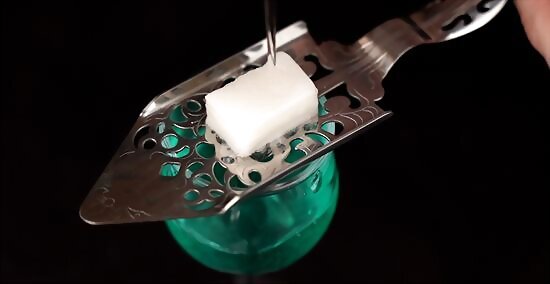
Drip very pure ice cold water into the absinthe from a small pitcher. This very slow and gradual addition of the water forms the heart of the absinthe ritual, and is done with or without the sugar. When using sugar, the cold water is dripped over the sugar and into the drink, causing the sugar to slowly dissolve into the absinthe. Very high quality absinthe can be expertly experienced simply with the ice cold water. Three or four ounces of water are added per ounce of absinthe. Ice cubes can be added to the pitcher of water if desired, but be sure that they don't fall into the glass of absinthe. As the water is added to the absinthe, the absinthe should gradually louche. Absinthe fountains were traditionally used to drip the ice cold water into absinthe drinks. Brouilleur devices can also be used to automatically drip the water into individual glasses. The brouilleur is placed over the glass, and water, ice cubes, or ice water (as well as sugar if desired) is added to it. The water will gradually drip through the brouilleur into the absinthe. The brouilleur is removed before drinking the prepared absinthe.
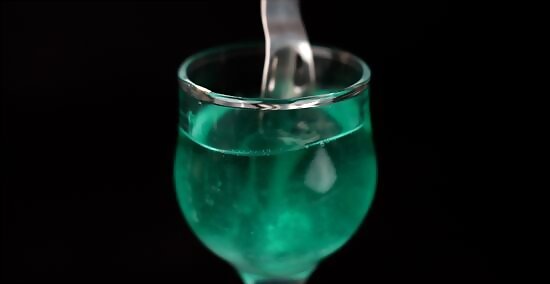
Stir the drink with the absinthe spoon after the water has been added. Two or three ice cubes can be added to the finished drink, but this practice may be frowned upon by absinthe purists.
Czech or Modern Bohemian
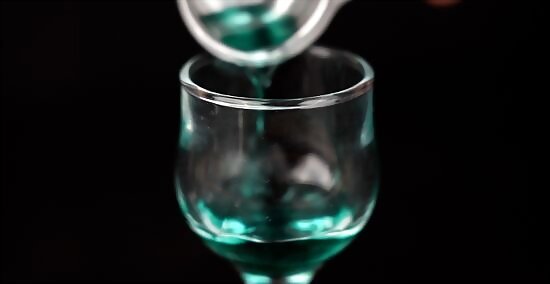
Pour a dose of absinthe into a glass, then place a sugar cube on an absinthe spoon or teaspoon.
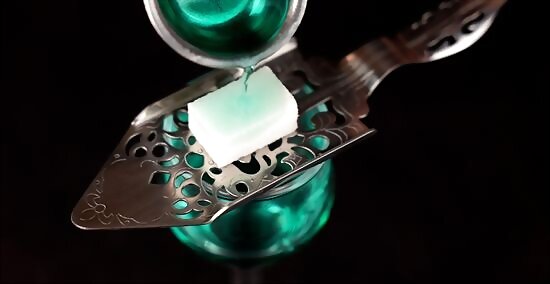
Soak the sugar in absinthe by dipping it into the absinthe with the spoon or pouring a little absinthe over it.
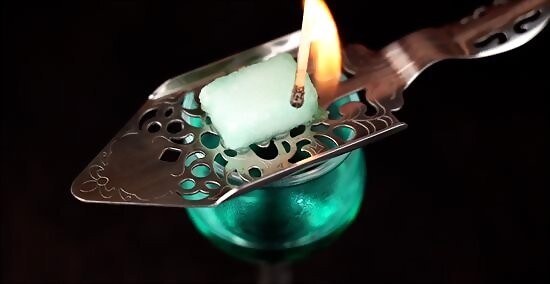
Light the absinthe-soaked sugar on fire for about one minute, allowing the sugar to begin to caramelize. (This is not recommended because it can be extremely dangerous due to the high alcohol content which makes the absinthe very flammable). If an absinthe spoon is used, take care that the sugar does not burn, nor drip into the absinthe, ruining its flavor.
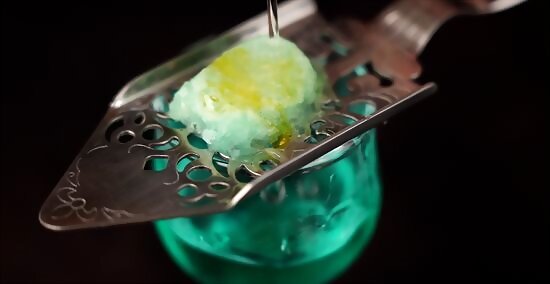
Pour ice-cold water over the sugar cube before it begins turning brown and burning. This process should produce the louche effect.
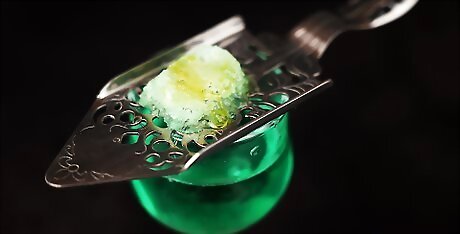
Use this method appropriately. Though frowned upon by some absinthe aficionados, this untraditional method has become popular in recent years. Absinthe with a high alcohol content will ignite more readily, but it is certainly not recommended that high-quality absinthe be set aflame.
"Glass in a Glass"
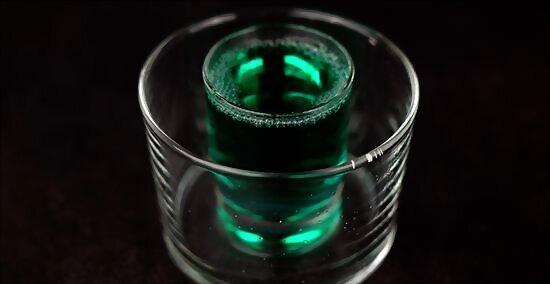
Place a small glass full of absinthe (containing one ounce of absinthe) inside a larger empty glass.
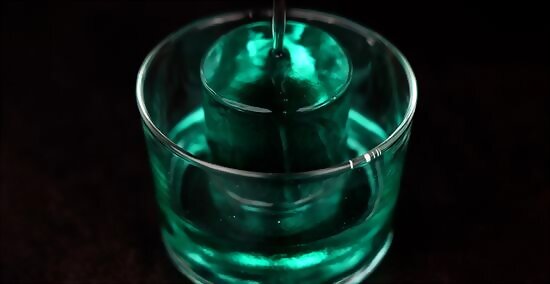
Drip the cold water into the small glass, causing the contents of the small glass to overflow into the larger glass. Once the three or four ounces of water have been added, the large glass will contain the absinthe and water mixture, while the small glass will just contain water.
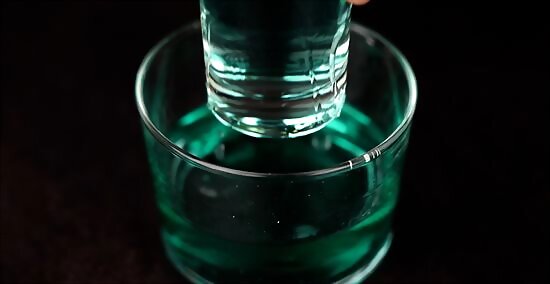
Remove the small glass from the larger glass before drinking the absinthe from the larger glass.
"Backdraft"
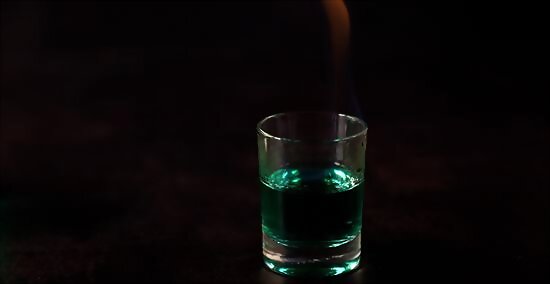
Note that this method can be dangerous if done improperly. Because it involves lighting the absinthe on fire and then placing your palm over the shot glass to extinguish the flame, you're quite literally toying with fire. If you are unsure about the directions or feel unsafe about the thought of performing them, please do not attempt. You're literally toying with fire. Also understand that this method involves drinking a shot of absinthe straight, without dilution. As absinthe can be an incredibly strong alcohol, this method is not recommended for light drinkers.
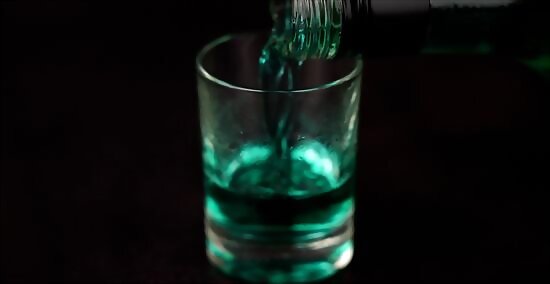
Get a small shot glass and fill about ¾ of it with absinthe. Make sure the absinthe does not fill the shot glass completely. Also make sure that the palm of your hand fits comfortably over the whole rim of the shot glass. You will not be able to perform the backdraft trick if the rim of the glass is bigger than your palm.
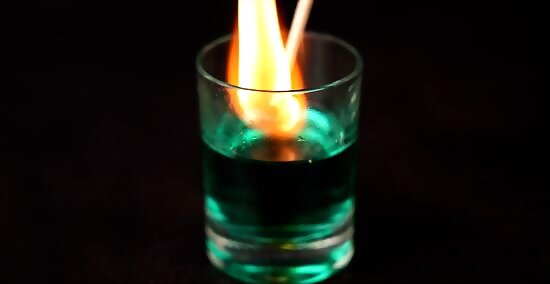
With a match or a lighter, set fire to the shot of absinthe. The flame should take immediately and burn easily because of the alcohol content of absinthe. Note: Do not let the absinthe burn for a long time. Bad things can happen the longer you let the absinthe burn. The shot glass gets hotter, increasing the risk of burning your hand. The flame also burns away the alcohol and herbs of the absinthe, ruining the delicate flavors. Also, your glass can crack if you let the flame burn too long, or, if you're using a plastic cup, it can melt (and also release plastic fumes).
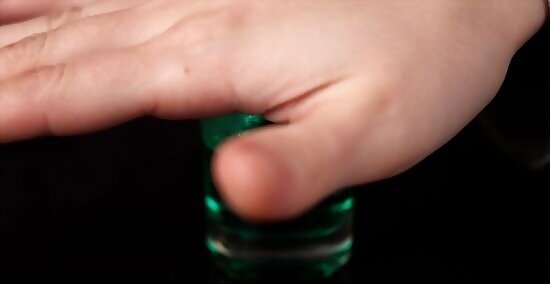
Quickly place your palm over the rim of the shot glass, covering it completely and extinguishing the fire.Do this no longer than 5 seconds after setting the drink ablaze. You should feel a suction effect if you place your hand over the entire rim of the shot glass. Although you'd think it would burn to place your hand over the flame, the flame is pretty much immediately choked out since it no longer has any oxygen to serve as fuel. Counterintuitively, this process shouldn't hurt at all if you don't let the absinthe burn for very long.
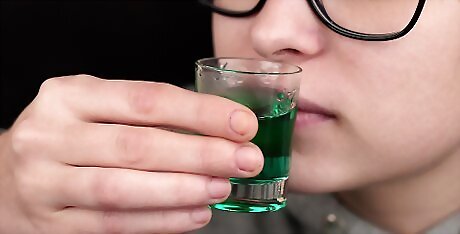
Bring the shot glass to your nose, slowly break the suction, and breathe in the alcohol vapor produced by the flame. Lightly remove only a portion of your palm from the shot glass instead of removing your entire hand at once.
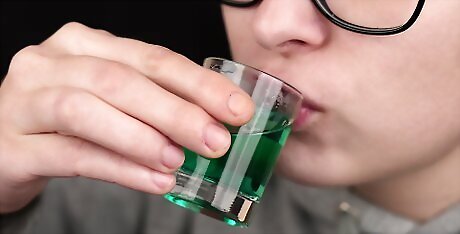
Sip or shoot the shot of absinthe. Enjoy it at your leisure or down it in one fell swoop.
Neat Absinthe
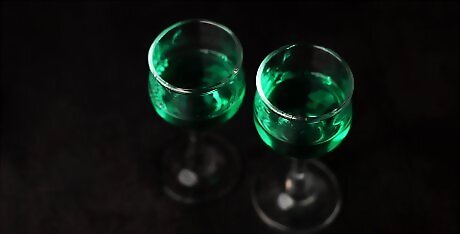
Drink absinthe straight (neat). It may be ideal to taste vintage absinthe neat, as this will enable one to evaluate some of the particular nuances of a particular sample of absinthe.
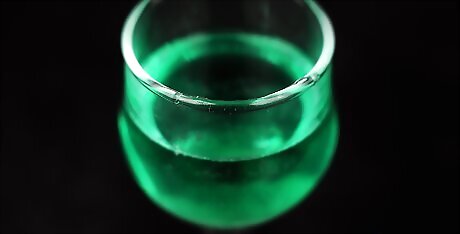
Keep in mind that this is not customary due to the very high alcohol content of traditional absinthe.
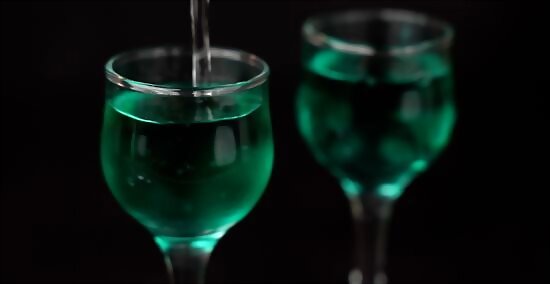
Remember that the louche effect is a very important quality of absinthe, however, and should therefore be experienced when preparing quality absinthe.
Enjoying Absinthe in Cocktails
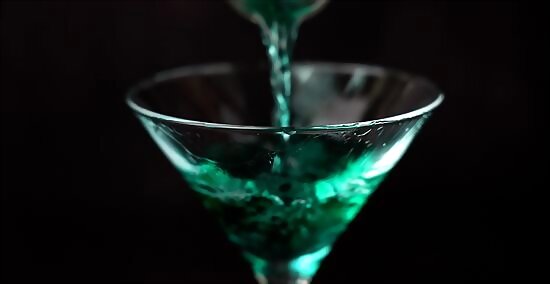
Try a Death in the Afternoon. Simple and sophisticated, this drink was famously described by Ernest Hemingway. Quoth the American master: "Pour 1 jigger of absinthe into a champagne glass. Add iced [brut] champagne until it attains the proper opalescent milkiness. Drink three to five of these slowly."
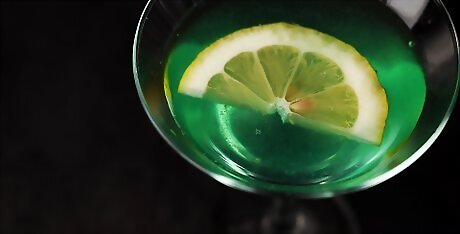
Try an absinthe sazerac. The sazerac, created by Antoine Amédée Peychaud in the early 1800s, is one of the oldest known cocktails. Add a little absinthe to this stellar recipe to make it really stand out. Add three dashes of absinthe to a bucket glass nearly filled with ice cubes. In a cocktail shaker with ice, mix vigorously: 2 ounces Osocalis brandy ¼ ounce simple syrup 2 dashes Peychaud’s bitters. Pour contents of cocktail shaker into bucket glass. Stir lightly and wipe rim with lemon zest before adding it as a garnish. Finished.
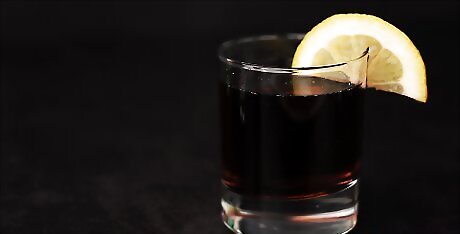
Try an absinthe sour. Using fresh lemon juice pairs nicely with the herbs in absinthe and the botanicals in gin. Try this interesting cocktail if you have fresh lemons, absinthe, and gin handy! Mix the following vigorously in an ice-filled cocktail shaker and strain into a martini glass: ½ oz. absinthe 1 teaspoon caster sugar ¾ oz. lemon juice (juice 1/2 lemon) 1 oz. gin.
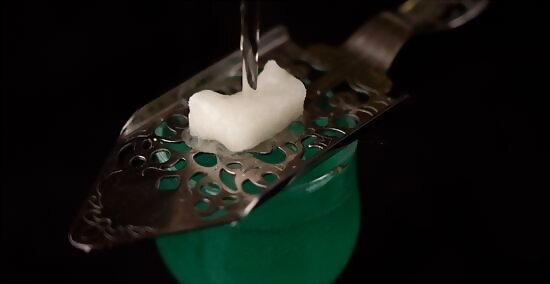
Try Rosalie's hot French kiss. Prepare to fix absinthe using the Classic French method. Replace the ice cold water with hot mint tea. Continue using the French method. Enjoy!
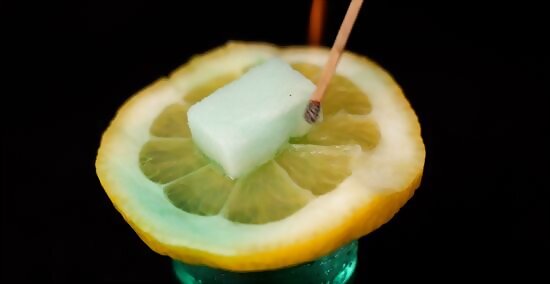
Have a Kalashnikov shot. Place 1/2 lemon vodka in a shot glass. Fill 1/2 with absinthe. Float a slice of lemon on top. Place a sugar cube on top of the lemon. Drip on more absinthe. Light it on fire. Blow out the flame or use the backdraft method of putting your palm over the cup. Drink the shot.


















Comments
0 comment